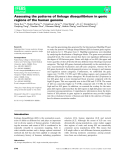
Patterns of internal
-
Factors influencing housing development patterns in international border towns in Ogunstate, Nigeria
The study affirms that both physical factors and neighbourhood factors largely and significantly influence housing formation patterns in the international borders. Therefore, there is need for Nigeria government most specially to take cognizance of these important factors when formulating or developing her housing development plan.
 15p
15p  lucastanguyen
lucastanguyen
 01-06-2020
01-06-2020
 17
17
 3
3
 Download
Download
-
Increasing disposable income of the consumers has transformed the buying pattern to a greater extent. Before shopping by people was very rare phenomenon but nowadays shopping is part and parcel of most of the households in which shoppers spend substantial amount on impulse buying.
 5p
5p  guineverehuynh
guineverehuynh
 17-06-2020
17-06-2020
 28
28
 4
4
 Download
Download
-
Polypropylene/ maleic anhydride /organic montmorillonite nanocomposites (PP/ MA/ Org-MMT) have been prepared via direct melt intercalation in an internal mixer. Maleic anhydride (MA) was used as a compatibilizer to improve the dispersability of the clay. The structures of nanocomposites have been characterized by X-ray diffraction (XRD), transmission electron microscopy (TEM) and scanning electron microscopy (SEM). Mechanical properties and thermal stability were determined by tensile analysis and thermogravimetric analysis (TGA), respectively.
 8p
8p  12120609
12120609
 01-06-2020
01-06-2020
 20
20
 2
2
 Download
Download
-
E2F transcription factors play an important role in the regulation of cell cycle progression. E2F6, the most recently identified member of the E2F family, is a retinoblastoma-protein-independent transcriptional repressor that is required for developmental patterning of the axial skeleton. It has recently been shown that theE2f6locus produces two different mRNAs, E2F6 and E2F6b. The E2F6b mRNA contains an additional exon that is inserted by alternative splicing.
 7p
7p  tumor12
tumor12
 22-04-2013
22-04-2013
 32
32
 1
1
 Download
Download
-
We used the genotyping data generated by the International HapMap Project to study the patterns of linkage disequilibrium (LD) in human genic regions. LD patterns for 11 998 genes from 11 HapMap populations were identified by analyzing the distribution of haplotype blocks.
 8p
8p  cosis54
cosis54
 09-12-2012
09-12-2012
 43
43
 3
3
 Download
Download
CHỦ ĐỀ BẠN MUỐN TÌM


















